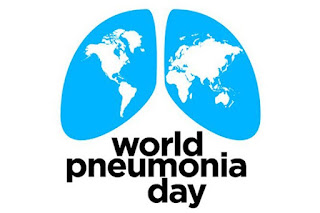The World Pneumonia Day seeks to raise awareness of pneumonia as a public health issue and help prevent the millions of avoidable child deaths from pneumonia that occur each year. It is organized by the Global Coalition against Child Pneumonia (a network of international, government, non-governmental and community-based organizations, research and academic institutions, foundations, and individuals) to bring much-needed attention to pneumonia among donors, policy makers, health care professionals, and the general public.(1)
World Pneumonia Day, marked every year on November 12, was established in 2009 to raise awareness about the toll of pneumonia—a leading killer of children around the world—and to advocate for global action to protect against, help prevent, and effectively treat this deadly illness. (2)
Objectives:
- Raise awareness about pneumonia, the world’s leading killer of children under the age of five;
- Promote interventions to protect against, prevent and treat pneumonia; and
- Generate action to combat pneumonia.
The WHO integrated Global Action Plan for Pneumonia and Diarrhoea (GAPPD) aims to:
Pneumonia is preventable and treatable, yet remains a leading cause of death in children under 5 years old worldwide.
“In 2013 alone, more than 900,000 children died from this preventable and treatable illness, accounting for 15% of under-five child mortality worldwide, 2% of which are newborns” – UNICEF
We can prevent pneumoniaLet’s #StopPneumonia from taking the lives of infants around the world with proven interventions: exclusive breastfeeding, adequate nutrition, reduced household air pollution, clean water and sanitation, vaccines, and antibiotics.
Did you know?Pneumonia is the leading infectious killer of children under five worldwide. With safe and effective interventions to prevent and treat the disease, together we can work to ensure that all children reach their 5th birthdays. #StopPneumonia
Timely diagnosis is keyEffective, integrated case management strategies ensure that children receive proper and timely diagnosis of and treatment for pneumonia. Improving access to services and increasing awareness and demand for them within communities is crucial to #StopPneumonia.
http://stoppneumonia.org/advocate-resources/
- Pneumonia is a form of acute respiratory infection that affects the lungs. The lungs are made up of small sacs called alveoli, which fill with air when a healthy person breathes. When an individual has pneumonia, the alveoli are filled with pus and fluid, which makes breathing painful and limits oxygen intake.
- Pneumonia is the single largest infectious cause of death in children worldwide. Pneumonia killed 920136 children under the age of 5 in 2015, accounting for 16% of all deaths of children under five years old. Pneumonia affects children and families everywhere, but is most prevalent in South Asia and sub-Saharan Africa. Children can be protected from pneumonia, it can be prevented with simple interventions, and treated with low-cost, low-tech medication and care.
- Streptococcus pneumoniae – the most common cause of bacterial pneumonia in children;
- Haemophilus influenzae type b (Hib) – the second most common cause of bacterial pneumonia;
- respiratory syncytial virus is the most common viral cause of pneumonia;
- In infants infected with HIV, Pneumocystis jiroveci is one of the most common causes of pneumonia, responsible for at least one quarter of all pneumonia deaths in HIV-infected infants.
- Pneumonia can be spread in a number of ways. The viruses and bacteria that are commonly found in a child’s nose or throat, can infect the lungs if they are inhaled. They may also spread via air-borne droplets from a cough or sneeze. In addition, pneumonia may spread through blood, especially during and shortly after birth. More research needs to be done on the different pathogens causing pneumonia and the ways they are transmitted, as this is of critical importance for treatment and prevention.
- The presenting features of viral and bacterial pneumonia are similar. However, the symptoms of viral pneumonia may be more numerous than the symptoms of bacterial pneumonia. In children under 5 years of age, who have cough and/or difficult breathing, with or without fever, pneumonia is diagnosed by the presence of either fast breathing or lower chest wall indrawing where their chest moves in or retracts during inhalation (in a healthy person, the chest expands during inhalation). Wheezing is more common in viral infections.
- Very severely ill infants may be unable to feed or drink and may also experience unconsciousness, hypothermia and convulsions.
- While most healthy children can fight the infection with their natural defenses, children whose immune systems are compromised are at higher risk of developing pneumonia. A child’s immune system may be weakened by malnutrition or undernourishment, especially in infants who are not exclusively breastfed.
- Pre-existing illnesses, such as symptomatic HIV infections and measles, also increase a child’s risk of contracting pneumonia.
- The following environmental factors also increase a child’s susceptibility to pneumonia:
- indoor air pollution caused by cooking and heating with biomass fuels (such as wood or dung)
- living in crowded homes
- parental smoking.
- Treatment
- Preventing pneumonia in children is an essential component of a strategy to reduce child mortality. Immunization against Hib, pneumococcus, measles and whooping cough (pertussis) is the most effective way to prevent pneumonia.
- Adequate nutrition is key to improving children’s natural defences, starting with exclusive breastfeeding for the first 6 months of life. In addition to being effective in preventing pneumonia, it also helps to reduce the length of the illness if a child does become ill.
- Addressing environmental factors such as indoor air pollution (by providing affordable clean indoor stoves, for example) and encouraging good hygiene in crowded homes also reduces the number of children who fall ill with pneumonia.
- In children infected with HIV, the antibiotic cotrimoxazole is given daily to decrease the risk of contracting pneumonia.



